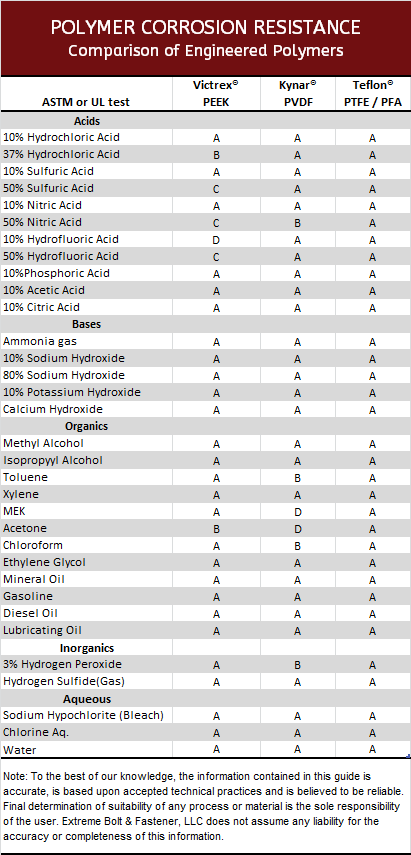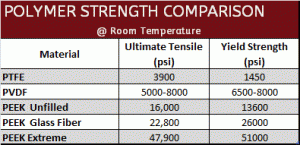 Choosing the right specialty polymer fastener for your corrosive application can be a confusing task. There are numerous material options, puzzling polymer acronyms and generally too much information. However, understanding the general chemical resistance of polymers will put you in a better position to make the best choice for your application. Let’s start by taking a brief look at the most popular corrosion resistant polymer materials – PEEK, PVDF and PTFE – and compare them.
Choosing the right specialty polymer fastener for your corrosive application can be a confusing task. There are numerous material options, puzzling polymer acronyms and generally too much information. However, understanding the general chemical resistance of polymers will put you in a better position to make the best choice for your application. Let’s start by taking a brief look at the most popular corrosion resistant polymer materials – PEEK, PVDF and PTFE – and compare them.
What is the most corrosion resistant polymer? – To provide a simple answer to this question, the following list generally ranks the corrosion resistance of these polymers with PTFE being at the top. Understanding that corrosion resistance is very dependent on the exact temperature, concentration and media, this can be used as a rough guide
So why not choose PTFE for any corrosive application if it’s the best? While PTFE has excellent chemical resistance there are typically other factors to consider especially for fasteners.
- Operating temperature
- Strength required at that temperature
While PTFE is one of the most corrosion resistant materials available, it is also a weak material and may not be suitable for the mechanical demands of some applications (see charts below). Conversely, PEEK is quite strong, especially when reinforced with glass or carbon fibers. While PEEK is not generally as corrosion resistant as PTFE, it still is very corrosion / chemically resistant to many type of media and may be sufficient for many applications. PVDF ranks somewhere in the middle in terms of both strength and corrosion resistance when compared to PEEK and PTFE.
The following polymer chemical resistance and strength data have been provided to help you compare the polymers. Additionally if you have specific questions regarding which corrosion / chemical resistant fastener materials is best for your application feel free to consult the materials experts at Extreme Bolt & Fastener.


